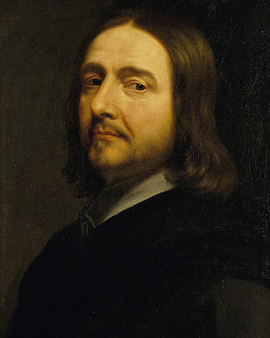Philippe de Champaigne was a French baroque painter with Flemish roots. Born into poor circumstances in Brussels, Champaigne first studied under Jacques Fouquier. From 1621 he lived and worked in Paris. In 1625, together with Nicolas Poussin and under the direction of the famous painter Nicolas Duchesne, he was commissioned to decorate the rooms of the Palais du Luxembourg. Champaigne is said to have been so talented that Duchesne quickly became jealous and saw his status threatened. Champaigne was forced to leave Paris and move back to Brussels, where he lived with his brother. When Duchesne finally died, the road to Paris was open again for Champaigne. When he returned to Paris, he even married Duchesne's daughter. The Queen Mother, Maria de Medici, appointed him Duchesne's successor as her first court painter shortly after his return. She was one of his greatest patrons and ensured that his career in France progressed rapidly.
As court painter, De Champaigne received a handsome pension of 1200 pounds per year. Not only did the Queen Mother herself give him many commissions, but her influence enabled the painter to obtain various commissions for King Louis XIII and the Cardinals Richelieu and Marzin. He was the only painter who was allowed to paint portraits of Richelieu. He painted the cardinal 11 times. The special thing about the portrait of the most influential cardinal of France was that he painted him standing and not sitting, unlike it was usual for dignitaries of the church. From 1643 Champaigne joined Jansenism, a religious movement within the Catholic Church, which was particularly popular in France at the time. From then on, influenced by his new faith, he began to reject many of the conventions common to the Baroque period. He simplified his portraits and refused to give the sitters fleeting facial expressions. Champaignes showed Flemish, French and Italian influences equally in his paintings. His portrait style was influenced by Peter Paul Rubens and Anthony van Dyck.
Probably the most important contribution of Champaign to French art was the co-founding of the Académie royale de peinture et de sculpture in 1648, which became one of the most important art institutions in France from the 18th century onwards. Champaigne himself initially taught at the Academy and later became its director. Among his students were his nephew Jean Baptiste de Champaigne, William Faithhorne and Nicolas de Plattemontagne. From the 1660s Champaign's fame declined and he was overshadowed by Charles Lebrun in particular. He then withdrew from Paris and lived in Port-Royal, a stronghold of Jansenism. His most famous work is from this period "Ex voto 1662" dates from this time. It shows his daughter, who became a nun in the monastery, praying with the abbess of the monastery.
×





.jpg)
.jpg)
.jpg)
.jpg)
 - (MeisterDrucke-652309).jpg)
 - (MeisterDrucke-652309).jpg)
.jpg)
.jpg)
.jpg)
.jpg)
.jpg)
.jpg)
.jpg)
.jpg)
.jpg)
.jpg)
_Abbess_of_Port-Royal_1654_-_(MeisterDrucke-34916).jpg)
_Abbess_of_Port-Royal_1654_-_(MeisterDrucke-34916).jpg)
.jpg)
.jpg)
 - (MeisterDrucke-172899).jpg)
 - (MeisterDrucke-172899).jpg)
.jpg)
.jpg)
.jpg)
.jpg)
.jpg)
.jpg)
.jpg)
.jpg)
_-_(MeisterDrucke-1120297).jpg)
_-_(MeisterDrucke-1120297).jpg)
 - (MeisterDrucke-66650).jpg)
 - (MeisterDrucke-66650).jpg)
.jpg)
.jpg)
_-_(MeisterDrucke-920454).jpg)
_-_(MeisterDrucke-920454).jpg)
.jpg)
.jpg)
.jpg)
.jpg)
_King_of_France_Painting_by_Philippe_de_Champa_-_(MeisterDrucke-987442).jpg)
_King_of_France_Painting_by_Philippe_de_Champa_-_(MeisterDrucke-987442).jpg)
.jpg)
.jpg)
_Dim_0_-_(MeisterDrucke-946690).jpg)
_Dim_0_-_(MeisterDrucke-946690).jpg)
 and Sister Catherine of St Suzanne Champaigne (1636-86) the artists daughter 1662 (for detail see 89737) - (MeisterDrucke-74938).jpg)
 and Sister Catherine of St Suzanne Champaigne (1636-86) the artists daughter 1662 (for detail see 89737) - (MeisterDrucke-74938).jpg)
.jpg)
.jpg)
 King of France and Navarre 1638 detail - (MeisterDrucke-138330).jpg)
 King of France and Navarre 1638 detail - (MeisterDrucke-138330).jpg)
.jpg)
.jpg)
 c1643-44 - (MeisterDrucke-100905).jpg)
 c1643-44 - (MeisterDrucke-100905).jpg)
.jpg)
.jpg)
.jpg)
.jpg)
_Painting_by_Philippe_de_Ch_-_(MeisterDrucke-982567).jpg)
_Painting_by_Philippe_de_Ch_-_(MeisterDrucke-982567).jpg)
.jpg)
.jpg)
_Painting_by_Philippe_de_Ch_-_(MeisterDrucke-946412).jpg)
_Painting_by_Philippe_de_Ch_-_(MeisterDrucke-946412).jpg)
 King of France and Navarre 1638 - (MeisterDrucke-85663).jpg)
 King of France and Navarre 1638 - (MeisterDrucke-85663).jpg)
_-_(MeisterDrucke-950379).jpg)
_-_(MeisterDrucke-950379).jpg)
.jpg)
.jpg)
.jpg)
.jpg)
.jpg)
.jpg)
.jpg)
.jpg)
 1650 - (MeisterDrucke-41738).jpg)
 1650 - (MeisterDrucke-41738).jpg)
_(_-_(MeisterDrucke-948149).jpg)
_(_-_(MeisterDrucke-948149).jpg)
 - (MeisterDrucke-103895).jpg)
 - (MeisterDrucke-103895).jpg)
.jpg)
.jpg)
.jpg)
.jpg)
_Receiving_Henri_dOrleans_(1595-1663)_Duc_de_Longueville_int_-_(MeisterDrucke-102914).jpg)
_Receiving_Henri_dOrleans_(1595-1663)_Duc_de_Longueville_int_-_(MeisterDrucke-102914).jpg)
.jpg)
.jpg)
.jpg)
.jpg)
.jpg)
.jpg)
.jpg)
.jpg)
.jpg)
.jpg)
 1658 - (MeisterDrucke-106544).jpg)
 1658 - (MeisterDrucke-106544).jpg)
.jpg)
.jpg)
.jpg)
.jpg)
.jpg)
.jpg)
 on his Deathbed - (MeisterDrucke-39284).jpg)
 on his Deathbed - (MeisterDrucke-39284).jpg)
_French_priest_theol_-_(MeisterDrucke-999474).jpg)
_French_priest_theol_-_(MeisterDrucke-999474).jpg)
.jpg)
.jpg)
 - (MeisterDrucke-88263).jpg)
 - (MeisterDrucke-88263).jpg)
.jpg)
.jpg)
.jpg)
.jpg)
.jpg)
.jpg)
.jpg)
.jpg)
.jpg)
.jpg)
 Crowned by Victory 1635 - (MeisterDrucke-52701).jpg)
 Crowned by Victory 1635 - (MeisterDrucke-52701).jpg)
.jpg)
.jpg)
.jpg)
.jpg)
.jpg)
.jpg)
.jpg)
.jpg)
.jpg)
.jpg)
.jpg)
.jpg)
_Colbert_(1619-1683)_intendant_of_finan_-_(MeisterDrucke-951296).jpg)
_Colbert_(1619-1683)_intendant_of_finan_-_(MeisterDrucke-951296).jpg)
_French_statesman_Painting_by_Schoo_-_(MeisterDrucke-1109811).jpg)
_French_statesman_Painting_by_Schoo_-_(MeisterDrucke-1109811).jpg)
.jpg)
.jpg)
.jpg)
.jpg)
.jpg)
.jpg)
.jpg)
.jpg)
 - (MeisterDrucke-59289).jpg)
 - (MeisterDrucke-59289).jpg)
_in_front_of_the_chapel_o_-_(MeisterDrucke-946924).jpg)
_in_front_of_the_chapel_o_-_(MeisterDrucke-946924).jpg)
_-_(MeisterDrucke-1515771).jpg)
_-_(MeisterDrucke-1515771).jpg)
_Ec_Flam_-_(MeisterDrucke-960178).jpg)
_Ec_Flam_-_(MeisterDrucke-960178).jpg)
.jpg)
.jpg)
.jpg)
.jpg)
 after 1610 - (MeisterDrucke-78910).jpg)
 after 1610 - (MeisterDrucke-78910).jpg)
.jpg)
.jpg)
.jpg)
.jpg)
.jpg)
.jpg)
.jpg)
.jpg)
.jpg)
.jpg)
.jpg)
.jpg)
.jpg)
.jpg)
.jpg)
.jpg)
.jpg)
.jpg)
.jpg)
.jpg)
.jpg)
.jpg)
.jpg)
.jpg)
.jpg)
.jpg)
.jpg)
.jpg)
.jpg)
.jpg)
.jpg)
.jpg)






